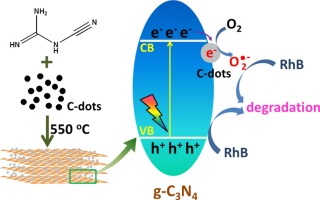当前位置:
X-MOL 学术
›
Appl. Catal. B Environ. Energy
›
论文详情
Our official English website, www.x-mol.net, welcomes your
feedback! (Note: you will need to create a separate account there.)
Effect of carbon-dots modification on the structure and photocatalytic activity of g-C3N4
Applied Catalysis B: Environment and Energy ( IF 20.2 ) Pub Date : 2015-12-24 03:36:06 Shun Fang, Yang Xia, Kangle Lv, Qin Li, Jie Sun, Mei Li
Applied Catalysis B: Environment and Energy ( IF 20.2 ) Pub Date : 2015-12-24 03:36:06 Shun Fang, Yang Xia, Kangle Lv, Qin Li, Jie Sun, Mei Li

|
As a promising metal-free photocatalyst, graphitic carbon nitride (g-C3N4) has attracted increasing attention. However, from the viewpoint of practical application, the quantum efficiency of g-C3N4 needs to be further improved. In this article, carbon dots (C-dots) modified g-C3N4 hybrid was successfully prepared by a novel strategy using C-dots and dicyandiamide as starting materials. The photocatalyst was characterized by scanning electron microscope (SEM), transmission electron microscopy (TEM), X-ray diffraction (XRD), FT-IR, UV–Vis diffuse reflectance spectrum (DRS), X-ray photoelectron spectroscopy (XPS), powder photoluminescence (PL) and surface photovoltage spectrum (SPS). Both the photocatalytic activity of C-dots modified g-C3N4 was evaluated by degradation of Rhodamine B under UV irradiation and photocatalytic hydrogen production under visible irradiation. The experimental results show that C-dots modification causes the lattice distortion of g-C3N4. With increase in the loading amount of C-dots, the photocatalytic activity of g-C3N4 increase first and then decrease. g-C3N4 modified with 0.25wt.% C-dots shows the highest photocatalytic activity, which is 3 times higher than pristine g-C3N4. C-dots act as electron-sinks, which prevent the recombination of photo-generated electron-hole pairs, enhancing the photocatalytic activity of g-C3N4. However, too much C-dots become recombination centers, which is detrimental to the photocatalytic activity of g-C3N4.
中文翻译:

碳点修饰对g-C3N4结构和光催化活性的影响
作为有前途的无金属光催化剂,石墨氮化碳(gC 3 N 4)引起了越来越多的关注。但是,从实际应用的观点出发,需要进一步提高gC 3 N 4的量子效率。在本文中,碳点(C点)修饰了gC 3 N 4通过使用C点和双氰胺为起始原料的新策略成功制备了杂合体。通过扫描电子显微镜(SEM),透射电子显微镜(TEM),X射线衍射(XRD),FT-IR,UV-Vis漫反射光谱(DRS),X射线光电子能谱(XPS),粉末光致发光(PL)和表面光电压谱(SPS)。C-点修饰的gC 3 N 4的光催化活性均通过若丹明B在紫外线照射下的降解以及可见光照射下的光催化产氢来评估。实验结果表明,碳点修饰引起gC 3 N 4的晶格畸变。随着C点的负载量增加,gC 3 N 4的光催化活性先增加然后降低。用0.25wt。%的碳点改性的gC 3 N 4表现出最高的光催化活性,是原始gC 3 N 4的3倍。C点充当电子吸收器,可防止光生电子空穴对的重组,从而增强gC 3 N 4的光催化活性。然而,太多的C-点成为重组中心,这不利于gC 3 N 4的光催化活性。
更新日期:2015-12-24
中文翻译:

碳点修饰对g-C3N4结构和光催化活性的影响
作为有前途的无金属光催化剂,石墨氮化碳(gC 3 N 4)引起了越来越多的关注。但是,从实际应用的观点出发,需要进一步提高gC 3 N 4的量子效率。在本文中,碳点(C点)修饰了gC 3 N 4通过使用C点和双氰胺为起始原料的新策略成功制备了杂合体。通过扫描电子显微镜(SEM),透射电子显微镜(TEM),X射线衍射(XRD),FT-IR,UV-Vis漫反射光谱(DRS),X射线光电子能谱(XPS),粉末光致发光(PL)和表面光电压谱(SPS)。C-点修饰的gC 3 N 4的光催化活性均通过若丹明B在紫外线照射下的降解以及可见光照射下的光催化产氢来评估。实验结果表明,碳点修饰引起gC 3 N 4的晶格畸变。随着C点的负载量增加,gC 3 N 4的光催化活性先增加然后降低。用0.25wt。%的碳点改性的gC 3 N 4表现出最高的光催化活性,是原始gC 3 N 4的3倍。C点充当电子吸收器,可防止光生电子空穴对的重组,从而增强gC 3 N 4的光催化活性。然而,太多的C-点成为重组中心,这不利于gC 3 N 4的光催化活性。





















































 京公网安备 11010802027423号
京公网安备 11010802027423号